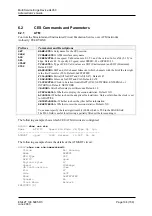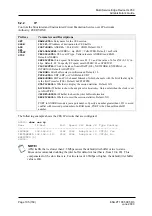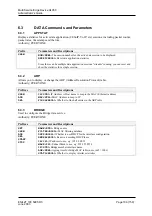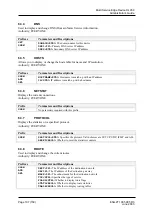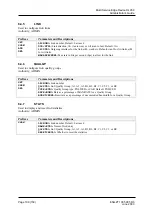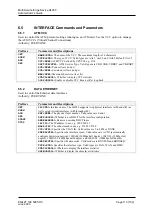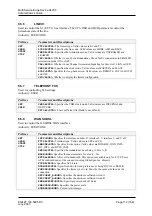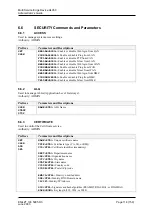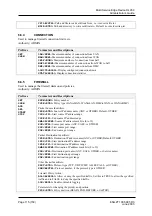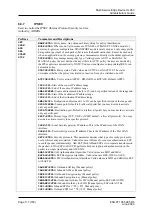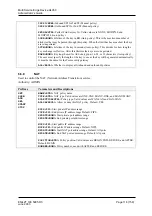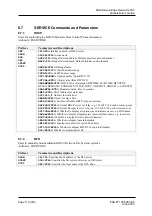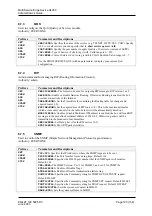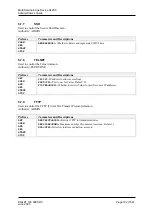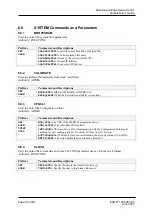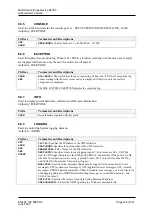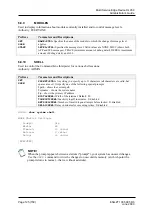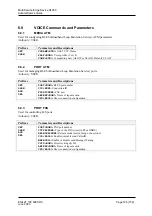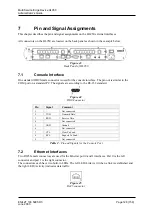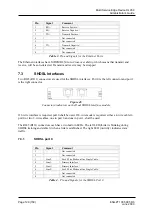
Multi Service Edge Device HL950
Administrator’s Guide
Page 117 (159)
EN/LZT 108 5995 R3
June
2003
6.6.7 IPSEC
Used to control the IPSEC (Internet Protocol Security) service.
Authority: ADMIN
Prefixes
Parameters and Descriptions
SET
SHOW
ADD
DEL
START
STOP
NAME<STR>
:
Policy name. Any unique arbitrary string for policy identification.
MODE<STR>
:
IPSec mode. Valid modes are TUNNEL or TRANSP. TUNNEL mode for
gateway-to-gateway configuration. TRANSPORT mode is rarely used as it only encrypts the
data portion (payload) of each packet, but leaves the header untouched. It must be used only
when an application on the security gateway communicates directly with another application.
TYPE<STR>
:
Key management policy type. Valid types are AUTO or MANUAL. In
MANUAL policy the user decides the keys while in AUTO policy the keys are decided by
the IPSec gateways automatically. NOTE! You must configure a corresponding IKE for an
automatic policy.
STATUS<STR>
:
Policy status. Valid values are ACTIVE or INACTIVE. The status
determines whether the policy is activated or inactive. It may be switched on or off.
ACTION<STR>:
Policy action; APPLY, DISCARD, or BYPASS. Default: APPLY
IPSS<IP>
:
Start of the source IP address range
IPSE<IP>
:
End of the source IP address range
SMASK<NUM>
:
Source address mask bits (1 to 32) can be specified instead of the range end.
IPDS<IP>
:
Start of the destination IP address range
IPDE<IP>
:
End of the destination IP address range
DMASK<IP>
:
Destination address mask (1 to 32) can be specified instead of the range end.
SPORT<NUM>
:
Source port. Default is 0 (allow all ports) but you may decide to activate
only a specific port.
DPORT<NUM>
:
Destination port. Default is 0 (allow all ports) but you may decide to activate
only a specific port.
PROT<STR>
:
Protocol type (TCP, UDP, or ICMP; default = allow all protocols). You may
decide to activate security for a specific protocol.
LSGW<IP>
:
Local Security gateway IP address. This is the IP address of the WAN
interface.
PSGW<IP>
:
Peer Security gateway IP address. This is the IP address of the Peer WAN
interface.
SECP<STR>
:
Security protocols. This parameter decides what type of security protocol to
use for this security association. Valid values are AH (used for source authentication), ESP
(used for packet confidentiality), AH+ESP (both AH and ESP as two separate transforms on
the packet), EWA (ESP with AUTH; performs both encryption and authentication on the
packet in a single transform), and AH+EWA.
AHALG<STR>
:
AH Authentication Algorithm. Valid values are MD5 and SHA1.
ESPALG<STR>
:
ESP Encryption Algorithm. Valid values are DES, 3DES, or AES.
EWAALG<STR>
:
EWA Authentication Algorithm. Valid values are MD5 and SHA1for ESP
with AUTH.
OAHKEY<STR>
:
Outbound AH key (Manual policy)
IAHKEY<STR>
:
Inbound AH key (Manual policy)
OEKEY<STR>
:
Outbound Encryption key (Manual policy)
IEKEY<STR>
:
Inbound Encryption key (Manual policy)
OEWAKEY<STR>
:
Outbound Auth key for EWA (Manual policy-ESP with AUTH)
IEWAKEY<STR>
:
Inbound Auth key for EWA (Manual policy-ESP with AUTH)
ISPI<NUM>
:
Inbound SPI for 1
st
TF (>255, Manual policy)
OSPI<NUM>
:
Outbound SPI for 1
st
TF (>255, Manual policy)


